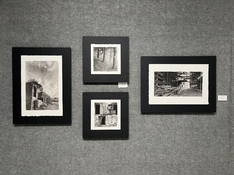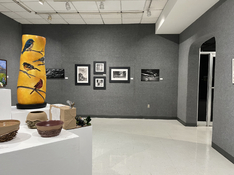While I have plenty of my traditional wet-printed photographs dry mounted, matted, and framed behind glass, I personally find glass to create a barrier for the viewer, especially when reflections are a problem. I had a small exhibition at the university a few years ago of a mixture of cyanotypes, Van Dykes, and silver-gelatin prints where I just placed them loose on a table and encourage viewers to pick the up to look at them. Yes, this creates some wear and tear but I wanted the viewers to have the opportunity to interact with them as much as to just view them.
Over the past dozen years or so, I produce more drawings and alt-process photos than conventional photographs and my preferred method for displaying them is to hang them with two small binder clips on the wall. I want the lack of pure flatness of the paper to be part of the work. However, some of my stuff has gone up on a year-long exhibition and I was told that the work really needed to be framed and covered with glass or acrylic to protect it from, well, handling. OK, I did that.
I have a new series of drawings, all based on my original photographs, and after a discussion with one of the art professors who sells quite a bit of work, I learned that, in her opinion, work that is framed under glass will more likely sell as this is what the buying public expects. I am framing this series, under glass but using spacers to keep the glass away from the paper and mounting the paper to the backing board using the t-hinge method, allowing it to float a bit.






 )
)